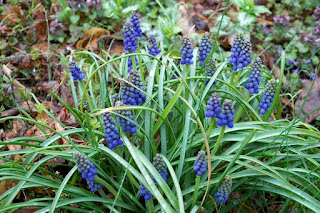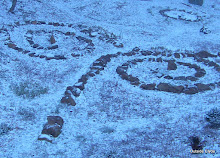The trails on the ridge top garden are well traveled. They are becoming ingrained in my memory. I can walk them in the thick undulating fog with some knowing comfort. I am not likely to squash something important if I stay on the paths.
Clumps of Muscari add to the growing diversity of blooming bulbs.

A couple of Fritillaria are wanting to bloom. Not being familiar with them, I would have thought them more a late spring, early summer bloomer and here there are now, showing up in the fog.

Forsythia must be as common as dirt, yet this is the first time in my life I have ever seen them bloom. Some of the Forsythia shrubs on the way to town are so outrageously bold they have to be admired. The impression of them being so common causes a gardener's boredom for me. I do not covet them.
They mark the entrance to one of the few trails into the wild forest. There is one well traveled path down to the stream and another defined path that makes a loop in the top corner of the property. The rest of the forest is wild.

If I want to know what is going on in there in more detail, I have to get off of the paths.
I may be the future king of Ramps. I keep finding more and bigger patches which will increase my fall seed collecting and sowing. I should actually find some recipes and try them out. I don't get out enough yet to worry about the reported days long lingering aroma. They are pungent. Trust me.

The Bloodroot, Sanguinaria canadensis is adding to the magic carpet that is the forest floor. Tomorrow it is supposed to be sunny and they should be in bloom.

In the fog I am more worried while I walk through the wild forest. Most likely I am stepping on something important still tucked beneath the leaves. I walk slowly, gingerly, making a mental map. Real trails through this forest may never come to be. It may be impossible to wind them close to everything there is to see.

This will be Squirrel Corn I think, Dicentra canadensis, a close relation and look alike to Dutchman's Breeches, Dicentra cucullaria.
More of the multiple species biodiversity of these mountains, a true testing of my botanizing. Now canadensis as a species name is growing in numbers with the caroliniana, virginiana and virginica. Let's see if I will be ever to keep this all straight?

The first Trilliums have arrived. How many species will there be? Will the Trilliums cause trouble?

There are also some unknowns for now. What will this be, an Orchid or a Lily family member?

The pleated leaves may be a clue. The Cypripediums, the Lady's Slippers have pleated leaves. The resident gardeners have said Showy Orchis, Galearis spectabilis grows here. If these pleats fade out that is another possibility. I find it hard to imagine that Lady's Slipper would escape their notice after all these years. Time will tell or maybe someone will recognize this right away.

Another unknown for now. The mottled coloration of the leaves is what caught my eye.

This is all just a small sampling of what is unfolding around me.






12 comments:
There is a book for you to write in all this, perhaps.
I do not desire a forsythia either, but if there was one native to northern California, I'm sure I would have put it in my garden. So what about Hamamelis and Calycanthus? Are those too common too?
The ramps sound more attractive and desirable all the time. I have top-setting onions because I understand the usual kind tends to bolt in San Francisco. They're just starting to top-set now.
And you have Fritillaries--surely a native species? I should think the South Africans wouldn't like the long humid summer.
The Hamamelis are on my want list. I need to know if the Calycanthus are vigorous spreaders by suckering before I might consider them, even though they are natives. There are such things as invasive natives. Clematis virginiana being one of them on my hit list targeted for unremorseful elimination, that and the blackberries.
I have no idea what the tree in the background of the three scenes is. I'll keep my eye on it to see when it leafs out if it becomes obvious.
Fritillaria are mostly a northern temperate zone species. You are just used to all that foreign exotic stuff in California from similar climates in the southern hemishpere. Some Fritillaria must have slipped down there?
Remind me, I'll have plenty Ramp seed in late September/October. It will challenge your germination skills and microclimate control.
Now how on earth could the trilliums cause any sort of trouble, Mr. Christopher?!
(Yes, I'm indignant at the thought. I love the trillium grandiflorum that carpet the woods behind my parents' house each spring. And I do mean carpet--it's absolutely amazing.) :)
What interesting things are revealed in Spring! Can't wait to see them in bloom.
True, there are some California frits, but one doesn't often see them. And they don't look as bold as yours. Yours looks more South African to me than any of California's.
The Trouble with Trilliums
Yes I know Kim, the Trilliums are so cute and dainty. There are nine possible species listed for my mountains. They can start interbreeding and seeding and before you know it the whole forest floor is a carpet of them.
They're so cute, I'll be caressing the leaves and stroking their petals, trying to enjoy all the subtle differences and identify and name them. There could be so many it will interfere with any other work getting done. No wall building, no vegetable gardening, no deadfall cleanup, it might hurt the Trilliums picking up the debris they are growing in, no garden expansion and planting, there are Trilliums in the way.
I'll spend all my time with the Trilliums. The Trouble with Trilliums.
Chuck I am fairly certain this is Fritillaria imperialis from Spain to Iran and the Himalayan foothills, the motherland of many bulbs.
I kind of miss forsythia tucked into the landscape, Christopher, but they do get gangly.
It's been a long time since I saw them grow, but don't Solomon's seals have pleated leaves when they first come up?
Your land gives you one delightful, small revelation after another... I can't imagine what it would be like to move in where someone like Bulbarella had lived...our houses were bought from non-gardeners in places where any wildlings had been long banished by mowers.
Annie at the Transplantable Rose
Annie it is amazing watching all this stuff pop out of the ground. The second wave of stuff has begun. Last year I did not see a lot of it because it was later in the year and because of the Great Easter Freeze of 07.
I will find out what Solomon's Seal looks like while coming up shortly. I have seen something that I think may be it.
This unknown in the forest already has a spiral leaf arrangement so I doubt it is Solomons Seal. One possibility is False Hellebore, Veratrum viride.
Christopher;
On a recent visit to Mt. Cuba Center for Native Plants in Delaware, I learned that ramps are good to eat IF cooked very well. Apparently they are way too pungent otherwise. In those parts they evidently have "ramps festivals" during the season, during which people demonstrate their ramps recipes.
I had never heard of ramps before your post. Thanks for a continuing education!
bev
Bev, our ramp festival is May 2nd. I am going to make an effort to get there.
The tiniest little snip of a leaf is 10x stronger than garlic. Ramp has a legendary lingering aroma.
More photos of the Fritillaria please. I have a dozen or so sprouting up myself. (My first time too.) I want to learn about these beautiful monsters.
As for Forsythia, from where I look at the world it is difficult NOT to love a bright yellow flowering shrub in early, early spring. They are like roman candles against the grey! One must just keep them trimmed (which you do NOW, just as soon as they finish blooming).
Forsythia sure do smell great, but they won't bloom much for me (too cold). Like Hank says, trim them up and you'll get zillions more blooms next year (in full sun). They are especially nice to cut and bring indoors with a bunch of daffs for a GOOD type of pungent!
Post a Comment